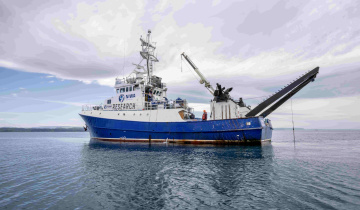Recently, Australian and New Caledonian shark scientists downloaded data from acoustic receivers deployed off the east coast of Australia and in the Coral Sea and discovered that great white sharks acoustically tagged in New Zealand had been visiting.
Great white sharks leave our shores during winter, in June or July, and swim all the way to tropical waters such as Tonga, New Caledonia and the Great Barrier Reef.
There are seven receivers set up at the Chesterfield Reefs in the Coral Sea. These receivers detect acoustically tagged sharks as they travel past them. An unnamed great white male shark, 3.3 metres long, was tagged at Stewart Island in March 2011 and then detected at Chesterfield Reefs in October 2011. Previously, great white sharks tagged with pop-up tags had visited the same area.
"Ella, a 4.4 metre-long great white shark was tracked from Stewart Island to New Caledonia in both 2009 and 2011," says NIWA Principal Scientist Dr Malcolm Francis. Another big great white shark, Phred, who is 4.8 metres long, was also tracked to Chesterfield Reefs in 2009.
There are 46 acoustic receivers off Sydney in Australia. Thirty-six of these are arranged in a line from just off Bondi Beach out to the edge of the continental shelf.
Australian scientists recently recorded a New Zealand great white shark, tagged by NIWA and Department of Conservation (DoC) at Stewart Island in March 2011, on their receivers.
"In January 2012 a 2.8 metre-long shark known as Meadsy was picked up on a receiver 10 kilometres off Bondi Beach," says Dr Francis. "It was picked up again at Stewart Island in February 2012 by our receiver array, having crossed the Tasman Sea in 21 days at an average speed of 96 kilometres per day. "
"The detection of our great white sharks by receivers deployed elsewhere in the southwest Pacific is a strong endorsement of the benefits of international cooperation among shark researchers," says Dr Francis.
In 2011, scientists tagged 25 great white sharks with acoustic tags and two with pop up tags on the Titi (Muttonbird) Islands off the northeast coast of Stewart Island. In 2012, they tagged 20 great white sharks with acoustic tags and five with pop up tags in the same area.
A recent download of the Stewart Island receivers has provided a second year of data on the local movements, times of departure, and arrival of great white sharks in the area.
Last year, the sharks left our shores at the end of June and started coming back between December and May. Many of the same white sharks are seen every year at Stewart Island, indicating an amazing ability to navigate back to the same spot after travelling thousands of kilometres across open ocean.
The researchers also want to find out when the sharks inhabit 'hotspot' locations such as Stewart Island, and the size of the New Zealand population of great whites.
"The tags and photo identifications help build a detailed picture of where they hang out, for how long and when they are there," says DoC scientist Clinton Duffy.
The tracking project is a collaboration between NIWA, DoC and Auckland University scientists. This research is funded mainly by the Ministry of Business, Innovation and Employment (MBIE), DoC, and NIWA.
The scientists working on the great white shark tracking project have also recently tagged a mako shark, Carol, who is 1.8 metres long, with a satellite-transmitting tag on her dorsal fin.
"Carol was tagged in May 2012, at the Bay of Islands, and she headed off halfway towards Fiji. She then came back to Ninety Mile Beach in Northland, where she spent six weeks, and then set off for Fiji again. She arrived off the Yasawa Islands last week having travelled 1900 kilometres in 28 days. Since she was tagged, Carol has swum nearly 6400 kilometres in 111 days, at an average of 58 kilometres per day."
This mako-tagging work was co-funded by US collaborator, Professor Mahmood Shivji from the Guy Harvey Research Institute at the Nova Southeastern University Oceanographic Center in Florida, and the Ministry for Primary Industries.
For comment, contact:
Dr Malcolm Francis
NIWA Principal Scientist
Clinton Duffy
Department of Conservation, Scientist








